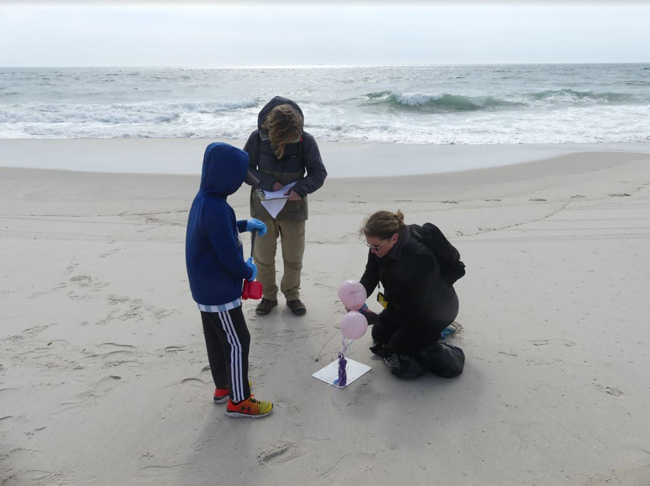
A team of volunteers records valuable data on balloon debris found on Jones Beach in March 2019 as part of a project to prevent such debris in the NY-Mid-Atlantic region. The next survey is scheduled for March 2020. Credit: Ryan Strother, NYSG
Reducing intentional balloon debris, one of the most prevalent and damaging “acceptable” forms of coastal littering, is uniting NYSG and Mid-Atlantic partners
Contact:
Krista Stegemann, NYSG Ocean & Marine Outreach Coordinator, E: ks2336@cornell.edu, P: (631) 632-8730
Stony Brook, NY, March 2, 2020 - Marine debris is a global issue that can threaten wildlife, habitats, and people. Unfortunately, while not intended to pollute, some debris is intentionally released into our environment. For instance, balloons are frequently released for celebratory or other reasons — often by people who would otherwise never “litter”. As a consequence, balloon debris is found in alarming quantity on New York’s shores and can cause considerable damage due to its resemblance to food for marine animals and entanglement risk.
To address balloon debris, New York Sea Grant is working with several partners to target this serious issue throughout the Mid-Atlantic region. This project, led by the Mid-Atlantic Regional Council on the Ocean and funded by the National Oceanic and Atmospheric Administration, addresses balloon debris through removal, data collection, and outreach programming designed to encourage people to refrain from releasing balloons and opt for more environmentally-friendly alternatives.
Data collection and removal efforts are well underway. In New York in 2019, this has included two balloon debris surveys and beach cleanup events during which volunteers collected valuable data while cleaning the most western mile of Jones Beach. More than 50 students, teachers, professionals, and community members removed 3,500-plus pieces of marine debris from the shore, including more than 400 pieces of balloon-related debris.
Although collection numbers varied based on cleanup date and factors such as recent storms, the basic ratio of balloon-related items (~10-20%) to general debris (~80-90%) remained the same over three events, indicating the need for public education aimed at preventing the release of balloons. The outreach portion of this project is currently in development.
As more information is gathered through regular surveys, the clearer our picture of the extent of balloon debris in NY will become. The next survey for this project is scheduled for March 28, 2020.
Through removal, data collection, and outreach, New York Sea Grant is working with partners to clean New York and Mid-Atlantic beaches of balloon debris as well as to educate and engage communities to prevent future balloon debris from polluting our shores.
The Sea Grant Focus Area for this project is Healthy Coastal Ecosystems.
Project Partners:
• Mid-Atlantic Regional Council on the Ocean (project lead)
• National Oceanic and Atmospheric Administration
• Marine Debris Program (funding)
• New York State Department of Environmental Conservation
• New York State Office of Parks, Recreation and Historic Preservation
• U.S. Environmental Protection Agency
More Info: New York Sea Grant
New York Sea Grant (NYSG), a cooperative program of Cornell University
and the State University of New York (SUNY), is one of 34 university-based
programs under the National Oceanic and Atmospheric Administration’s
National Sea Grant College Program.
Since 1971, NYSG has represented a statewide network of integrated
research, education and extension services promoting coastal community
economic vitality, environmental sustainability and citizen awareness
and understanding about the State’s marine and Great Lakes resources.
Through NYSG’s efforts, the combined talents of university scientists
and extension specialists help develop and transfer science-based
information to many coastal user groups—businesses and industries,
federal, state and local government decision-makers and agency managers,
educators, the media and the interested public.
The program maintains Great Lakes offices at Cornell University, SUNY
Buffalo, SUNY Oswego and the Wayne County Cooperative Extension office
in Newark. In the State's marine waters, NYSG has offices at Stony Brook
University in Long Island, Brooklyn College and Cornell Cooperative
Extension in NYC and Kingston in the Hudson Valley.
For updates on Sea Grant activities: www.nyseagrant.org has RSS, Facebook, Twitter, and YouTube links. NYSG offers a free e-list sign up via www.nyseagrant.org/nycoastlines for its flagship publication, NY Coastlines/Currents, which is published quarterly. Our program also produces an occasional e-newsletter,"NOAA Sea Grant's Social Media Review," via its blog, www.nyseagrant.org/blog.